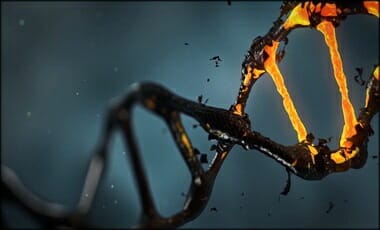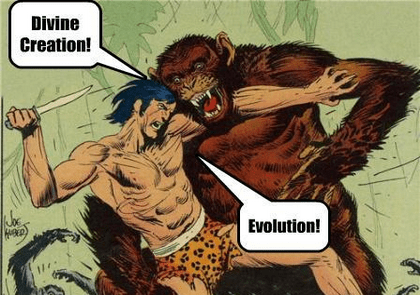PJ MEDIA UPDATE:
Thanks to a new study, evolutionists and their disciples are having to reexamine some of their most revered dogma. Particularly, evolutionists are now having to make sense of conclusions stating that almost all animal species, as well as humans, showed up on the stage of human history at the same time.
One of the constants of science is that science is constantly revising as it is challenged by new data, new theories, and new ways of observing and measuring data, not to mention the changes in scientific ideology molded by larger worldview shifts. Thomas Kuhn’s landmark book THE STRUCTURE OF SCIENTIFIC REVOLUTIONS provides a compelling argument for how scientific paradigms evolve, shift, and even jump to completely different tracks. However, within the many disciplines of science, evolution and evolutionists have remained dogmatic about the necessity of remaining committed to certain a priori assumptions. Well, as it turns out, some of evolution’s most revered a priori assumptions are now crumbling in the face of new research.
A study published in the JOURNAL HUMAN EVOLUTION is causing quite the stir. In the WORDS OF PHYS.ORG, “The study’s most startling result, perhaps, is that nine out of 10 species on Earth today, including humans, came into being 100,000 to 200,000 years ago.”
So startling, in fact, that according to David Thaler, one of the lead authors of the study, “This conclusion is very surprising, and I fought against it as hard as I could.”
The study’s very own author was so disturbed by how the conclusions challenged current scientific dogma that he “fought against it as hard as [he] could.” His “fight” gives credence to the study’s conclusions. His eventual acceptance, not to mention publication, of the conclusions speaks well of Thaler’s commitment to being a scientist first and an ideologue second.
[….]
This is no small matter for evolutionists because, as WORLD MAGAZINE helpfully summarizes:
According to traditional evolutionary thinking, all living things on Earth share common ancestry, with species evolving through a slow process of random mutation, natural selection, and adaptation over roughly 3.8 billion years. The idea that humans and most animals suddenly appeared at the same time a mere 200,000 years ago or less does not fit with that model.
[….]
Speaking of the study, World provides a concise explanation:
In the past, researchers studied DNA in the nucleus of cells, which differs markedly from one species to another. But the new study analyzed a gene sequence found in mitochondrial DNA. (Mitochondria, the powerhouses of cells, produce about 90 percent of a cell’s chemical energy.) Although mitochondrial DNA is similar across all humans and animals, it also contains tiny bits that are different enough to distinguish between species. This difference allows researchers to estimate the approximate age of a species.
The researchers analyzed these gene sequences in 100,000 species and concluded that the event—either the simultaneous appearance of humans and most animals, or a population crash—occurred about 100,000 to 200,000 years ago. That proposal challenges the bedrock of evolutionary theory.
An aside, this is how my mind works. As I was trying to figure out the title for this post, I went with the above. But then this reminded me of a skit by the Jerky Boys which I uploaded an excerpt from a while back that I have to share:
FOSSILS NEVER SUPPORTED
This is really old news… but with new DNA evidence to support the issue. I will post a paper I wrote many years ago in a debate with a friend. But here are a few quotes to peak curiosity:
- “…the fossil record doesn’t show gradual change, and every paleontologist has known that since Cuvier.” (Dr Gould, “Is a New and General Theory of Evolution Emerging?” Lecture at Hobart & William Smith Colleges; Feb 14, 1980.)
MORE:
Anthropologist EDMUND R. LEACH told the 1981 Annual Meeting of the British Association For The Advancement Of Science:
“Missing links in the sequence of fossil evidence were a worry to Darwin. He felt sure they would eventually turn up, but they are still missing and seem likely to remain so.”
DAVID RAUP, curator of geology at the Field Museum of Natural History in Chicago:
“He [Darwin] was embarrassed by the fossil record because it didn’t look the way he predicted it would and, as a result, he devoted a long section of his Origin of Species to an attempt to explain and rationalize the differences…. Darwin’s general solution to the incompatibility of fossil evidence and his theory was to say that the fossil record is a very incomplete one…. Well, we are now about 120 years after Darwin, and knowledge of the fossil record has been greatly expanded. We now have a quarter of a million fossil species but the situation hasn’t changed much. The record of evolution is still surprisingly jerky and, ironically, we have even fewer examples of evolutionary transition than we had in Darwin’s time. By this I mean that some of the classic cases of Darwinian change in the fossil record, such as the evolution of the horse in North America, have had to be discarded or modified as a result of more detailed information [archaeopteryx as well].”
Harvard paleontologist STEPHEN JAY GOULD, probably evolution’s leading spokesperson today, has acknowledged:
“The extreme rarity of transitional forms in the fossil record persists as the trade secret of paleontology. The evolutionary trees that adorn our textbooks have data only at the tips and nodes of their branches; the rest is inference, however reasonable, not the evidence of fossils.”
GEORGE GAYLORD SIMPSON, perhaps the twentieth century’s foremost paleontologist, said:
“This regular absence of transitional forms is not confined to mammals, but is an almost universal phenomenon, as has long been noted by paleontologists. It is true of almost all orders of all classes of animals, both vertebrate and invertebrate.”
DAVID B. KITTS of the school of Geology and Geophysics at the University of Oklahoma wrote:
“Despite the bright promise that paleontology provides a means of ‘seeing’ evolution, it has presented some nasty difficulties for evolutionists, the most notorious of which is the presence of ‘gaps’ in the fossil record. Evolution requires [key word, requires] intermediate forms between species and paleontology does not provide them.”
DR. STEVEN STANLEY of the department of Earth and Planetary Sciences, John Hopkins University, says:
“The known fossil record fails to document a single example of phyletic evolution accomplishing a major morphologic [structural] transition and hence offers no evidence that the gradualistic model can be valid.”
BEFORE the main article excerpt… here is how the researchers explained away the issue (GULF NEWS):
…The study’s most startling result, perhaps, is that nine out of 10 species on Earth today including humans came into being 100,000 to 200,000 years ago.
“This conclusion is very surprising, and I fought against it as hard as I could,” Thaler told AFP.
That reaction is understandable: How does one explain the fact that 90 per cent of animal life, genetically speaking, is roughly the same age?
Was there some catastrophic event 200,000 years ago that nearly wiped the slate clean?…
Here is TECH TIMES dealing with the issue:
Born Around The Same Time
In analyzing the COI of 100,000 species, Stoeckle and Thaler arrived at the conclusion that most animals appeared simultaneously. They found that the neutral mutation across species were not as varied as expected. Neutral mutation refers to the slight DNA changes that occur across generations. They can be compared to tree rings because they can tell how old a certain specie or individual is.
As to how that could have happened, it’s unclear. A likely possibility is the occurrence of a sudden event that caused large-scale environmental trauma and wiped out majority of the Earth’s species.
“Viruses, ice ages, successful new competitors, loss of prey — all these may cause periods when the population of an animal drops sharply,” explains Jesse Ausubel, director of the Program for the Human Environment.
Such times give rise to sweeping genetic changes across the planet, causing new species to appear. However, the last time such an occurrence took place was 65 million years ago, when an asteroid hit the Earth and killed off the dinosaurs and half of all other species on the planet.
The study is published in the journal Human Evolution.
So this article is an amazing confirmation in the growing body of new gene studies that have boomed in the last couple decades. It helps confirm a “creation event,” or what others would say is confirmation of a genetic bottleneck of the Great Flood, requiring new definitions and challenges to the status quo!
MY PREDICTION is you will here more about a flood caused by a meteor in an article from 2007:
Everything YEC’ers (young earth creationists) say happened in this mega flood has been derided for years… until recently. A Discover Magazine article entitled,
To explain this “early reporting,” see: Why Does Nearly Every Culture Have a Tradition of a Global Flood? (ICR)
This study of DNA just adds to the neo-Darwinian proposition being overturned and comes with thanks to BARBWIRE! All the emphasis is theirs:
An earth-shattering gene survey has confirmed that the best in science is perfectly consistent with the best in theology. This study, which should shake the theory of evolution to its roots, will probably get buried by the Talking Snake Media because it doesn’t fit their narrative. (Note, by the way, that evolution is a theory, not a fact. Don’t let them lie to you about this.)
In this seismic article on the WWW.PHYS.ORG website, sweeping gene survey reveals new facets of evolution, author Marlowe Hood reports on a study of five million gene snapshots – referred to as “DNA barcodes” – that are on deposit in the GenBank database, which is managed by the U.S. government.
These DNA barcodes have been taken from about 100,000 animal species by researchers all over the world. The findings were published last week by Mark Stoeckle of the Rockefeller University in New York and David Thaler of the University of Basel in Switzerland. These findings are “sure to jostle, if not overturn, more than one settled idea about how evolution unfolds.” That’s the understatement of the year.
These findings are more like an atomic bomb going off under the hoax of Darwinian evolution. This study, interestingly enough, was prompted by a handheld genetic test which is used to bust sushi bars trying to pass off tilapia for tuna.
The first nuclear bombshell is – get ready for this – that virtually all living things came into being at about the same time.
“The study’s most startling result, perhaps, is that nine out of 10 species on Earth today, including humans, came into being 100,000 to 200,000 years ago.
‘This conclusion is very surprising, and I fought against it as hard as I could,’ Thaler told AFP.
That reaction is understandable: How does one explain the fact that 90 percent of animal life, genetically speaking, is roughly the same age?” (Emphasis mine throughout.)
“Surprising” indeed. More like volcanically explosive. And the question is absolutely penetrating: how can evolution possibly be true when the scientific evidence, based on the best in genetic research, reveals that all living things came into existence at about the same time?
[….]
Here is the pull quote of seismic proportions: “In analysing the barcodes across 100,000 species, the researchers found a telltale sign showing that almost all the animals emerged about the same time as humans.”
How indeed do we explain the fact that all animal life is the same age? Well, creation scientists and students of the Bible have a perfectly coherent explanation. The reason that all living things, including human beings, are the same age is that the Creator created them all at the same time, just as Genesis 1 tells us.
The study reveals another jolting discovery, which likewise is fatal for the theory of evolution. While Darwinian evolution requires an untold number of transitional forms, forms that are somewhere between one life form and another, the fossil record has no transitional fossils for which a credible case can be made, not one.
Darwin himself recognized the problem of missing links in his own day, and optimistically believed that time would solve the problem – he figured as more and more fossils were discovered, missing links would finally be found. Alas for Darwin, we actually have fewermissing links today than in his day, as advances in science have revealed that forms once considered transitional aren’t transitional forms at all.
As Stephen Jay Gould, one of the preeminent paleontologists in the world, said, “The extreme rarity of transitional forms in the fossil record persists as the trade secret of paleontology.”
That sets the stage for the second utterly revolutionary pull quote from the article. “And yet—another unexpected finding from the study—species have very clear genetic boundaries, and there’s nothing much in between.” In other words, the reason that no transitional forms have ever been found is quite simple: there aren’t any.
Predictions Made About Fossils by Papa Giorgio on Scribd





